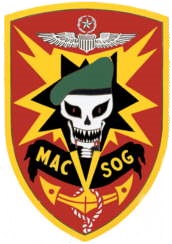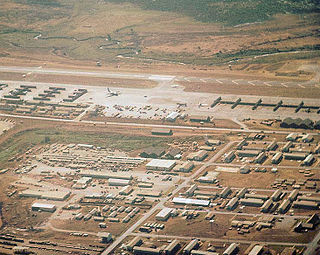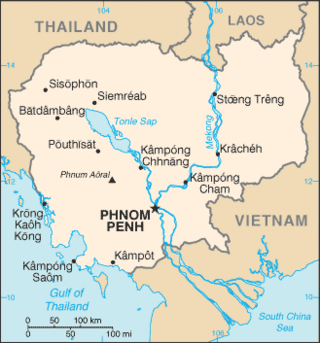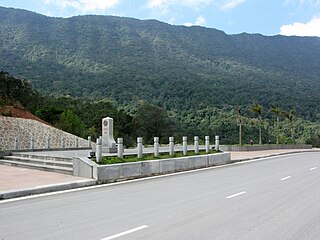
The Ho Chi Minh Trail, also called Annamite Range Trail was a logistical network of roads and trails that ran from North Vietnam to South Vietnam through the kingdoms of Laos and Cambodia. The system provided support, in the form of manpower and materiel, to the Viet Cong and the People's Army of Vietnam (PAVN), during the Vietnam War. Construction for the network began following the North Vietnamese invasion of Laos in July 1959.
Yankee Station was a fixed coordinate off the coast of Vietnam where U.S. Navy aircraft carriers and support ships operated in open waters over a nine-year period during the Vietnam War. The location was used primarily by aircraft carriers of Task Force 77 to launch strikes over North Vietnam. While the coordinate's official designation was "Point Yankee", it was universally referred to as Yankee Station. Carriers conducting air operations at Yankee Station were said to be "on the line" and statistical summaries were based on days on the line. Yankee Station was initially located at 16° 00′ N, 110° 00′ E, however with a massive increase in operations over North Vietnam in 1966 the station was moved about 145 miles (230 km) northwest to 17° 30′ N, 108° 30′ E, placing it about 90 miles (145 km) from the North Vietnamese shore.

Operation Rolling Thunder was a gradual and sustained aerial bombardment campaign conducted by the United States (U.S.) 2nd Air Division, U.S. Navy, and Republic of Vietnam Air Force (RVNAF) against the Democratic Republic of Vietnam, China and North Korea from 2 March 1965 until 2 November 1968, during the Vietnam War.

Operation Commando Hunt was a covert U.S. Seventh Air Force and U.S. Navy Task Force 77 aerial interdiction campaign that took place during the Vietnam War. The operation began on 15 November 1968 and ended on 29 March 1972. The objective of the campaign was to prevent the transit of People's Army of Vietnam (PAVN) personnel and supplies on the logistical corridor known as the Ho Chi Minh Trail that ran from the southwestern Democratic Republic of Vietnam through the southeastern portion of the Kingdom of Laos and into the Republic of Vietnam.
Operation Igloo White was a covert United States joint military electronic warfare operation conducted from late January 1968 until February 1973, during the Vietnam War. These missions were carried out by the 553d Reconnaissance Wing, a U.S. Air Force unit flying modified EC-121R Warning Star aircraft, and VO-67, a specialized U.S. Navy unit flying highly modified OP-2E Neptune aircraft. This state-of-the-art operation utilized electronic sensors, computers, and communications relay aircraft in an attempt to automate intelligence collection. The system would then assist in the direction of strike aircraft to their targets. The objective of those attacks was the logistical system of the People's Army of Vietnam (PAVN) that snaked through southeastern Laos and was known as the Ho Chi Minh Trail.

Military Assistance Command, Vietnam – Studies and Observations Group (MACV-SOG) was a highly classified, multi-service United States special operations unit which conducted covert unconventional warfare operations before and during the Vietnam War.

For decades, Task Force 77 was the aircraft carrier battle/strike force of the United States Seventh Fleet in the United States Navy (USN), a designation lasting from the final year of the Second World War until the disestablishment of the task force in 2000.

Marine Fighter Attack Squadron 542 (VMFA-542) is a United States Marine Corps Aviation fighter attack squadron transitioning to the F-35B Lightning II. VMFA-542 is based at Marine Corps Air Station Cherry Point, North Carolina and falls under the command of Marine Aircraft Group 14 (MAG-14) and the 2nd Marine Aircraft Wing.

Pleiku Air Base is a former air force base in Vietnam. It was established by the Republic of Vietnam Air Force (RVNAF) in 1962 at an undeveloped airstrip, and was used by the United States Air Force during the Vietnam War in the II Corps Tactical Zone of South Vietnam. It was captured by the People's Army of Vietnam (PAVN) in March 1975 and was abandoned for many years. Today, the facility has just redeveloped as Pleiku Airport。
Ubon Royal Thai Air Force Base is a Royal Thai Air Force (RTAF) facility located near the city of Ubon Ratchathani, in Ubon Ratchathani Province. It is approximately 488 km northeast of Bangkok. The Laos border is about 60 kilometres (37 mi) directly east. The facility is also used as a civil airport.

Operation Steel Tiger was a covert U.S. 2nd Air Division, later Seventh Air Force and U.S. Navy Task Force 77 aerial interdiction effort targeted against the infiltration of People's Army of Vietnam (PAVN) men and material moving south from the Democratic Republic of Vietnam through southeastern Laos to support their military effort in the Republic of Vietnam during the Vietnam War.

Operation Barrel Roll was a covert U.S. Air Force 2nd Air Division and U.S. Navy Task Force 77, interdiction and close air support campaign conducted in the Kingdom of Laos between 14 December 1964 and 29 March 1973 concurrent with the Vietnam War. The operation resulted in 260 million bombs being dropped on Laos, making Laos "the most heavily bombed nation in history".

The Sihanouk Trail was a logistical supply system in Cambodia used by the People's Army of Vietnam (PAVN) and its Viet Cong (VC) guerillas during the Vietnam War (1960–1975). Between 1966 and 1970, this system operated in the same manner and served the same purposes as the much better known Ho Chi Minh trail which ran through the southeastern portion of the Kingdom of Laos. The name is of American derivation, since the North Vietnamese considered the system integral to the supply route mentioned above. U.S. attempts to interdict this system began in 1969.

Seventh/Thirteenth Air Force was an operational headquarters that controlled United States Air Force tactical combat operations from Thailand during the Vietnam War. It was established in 1966 when Seventh Air Force replaced the 2d Air Division as the USAF headquarters in South Vietnam and was discontinued in 1973, when Seventh Air Force moved its headquarters from Vietnam to Thailand. Its combat units were attached to it for operations, but were assigned to Thirteenth Air Force in the Philippines for administration.
Operation Freedom Deal was a United States Seventh Air Force interdiction and close air support campaign waged in Cambodia between 19 May 1970 and 15 August 1973, as an expansion of the Vietnam War, as well as the Cambodian Civil War. Launched by Richard Nixon as a follow-up to the earlier ground invasion during the Cambodian Campaign, the initial targets of the operation were the base areas and border sanctuaries of the People's Army of Vietnam (PAVN) and the Viet Cong (VC).

Operation Niagara was a U.S. Seventh Air Force close air support campaign carried out from January through March 1968, during the Vietnam War. Its purpose was to serve as an aerial umbrella for the defense of the U.S. Marine Corps Khe Sanh Combat Base on the Khe Sanh Plateau, in western Quang Tri Province of the Republic of Vietnam. The base was under siege by an estimated three-divisional force of the People's Army of Vietnam (PAVN).

Forward air controllers (FACs) played a significant part in the Vietnam War from the very start. Largely relegated to airborne duty by the constraints of jungled terrain, FACs began operations as early as 1962. Using makeshift propeller-driven aircraft and inadequate radio nets, they became so essential to air operations that the overall need for FACs would not be completely satisfied until 1969. The FAC's expertise as an air strike controller also made him an intelligence source, munitions expert, communication specialist, and above all, the on-scene commander of the strike forces and the start of any subsequent combat search and rescue if necessary.

The Mụ Giạ Pass is a mountain pass in the Annamite Range between northern Vietnam and Laos, located 90 km northwest of Đồng Hới, Vietnam. The pass is 418 m above sea level and connects National Road 15 from Tân Ấp in Vietnam to Route 12 in Khammouane Province in Laos.

The 606th Special Operations Squadron is an inactive unit of the United States Air Force. The squadron was first activated as the 606th Air Commando Squadron in March 1966 and stationed at Nakhon Phanom Royal Thai Air Force Base, Thailand. The squadron flew C-123 Provider and A-26A bomber aircraft over the Ho Chi Minh trail at night during the Vietnam War to interdict the movement of people and equipment. The squadron was inactivated on 30 June 1971.
Charles Larimore Jones, also known as Charlie Jones, was an architect of the U.S. Air Force's forward air control doctrine, as well as one of its early practitioners during the Laotian Civil War. He was trained in forward air control techniques as a Combat Controller in 1954. In 1962, he was one of the Operation Jungle Jim volunteers who reestablished the Air Commandos. He was the first Combat Controller committed solely to support the U.S. Army Special Forces. Based on his experience, in 1963 he was assigned to Hurlburt Field to write the field manual on forward air control while expanding the Combat Controller curriculum.














